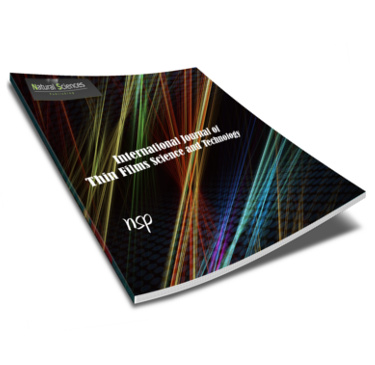International Journal of Thin Film Science and Technology

Abstract
The studies of the semiconductor core shell nanoparticles have advanced at a rapid pace because of the fact that their optical properties can be systematically tuned by varying their sizes. ZnS/ZnO thin films were deposited on FTO and glass substrate by using chemical bath deposition (CBD) technique. The chemical baths contain the solutions to zinc acetate, thiourea, ammonia and deionized water. The deposition of the samples was prepared by 300min.The deposition parameters such as pH of the bath; deposition time, temperature etc. be optimized. The morphological analysis of thin films is studied by using Scanning Electron Microscope instruments. The SEM pictures to revealing that it is in flower like structure of micrometer size of FTO and cluster formation of glass substrate. The estimated average grain size of FTO is 50-60nm it is whitish well substrate covered and for glass is 30-40nm. Elemental analysis of ZnS/ZnO thin film is determined by using EDAX. The proportion of the constituent elements measured was Zn = 34.39% for FTO substrate is higher than the glass substrate Zn=16.06%.. The proportion of the constituent elements measured was S=1.35%, O=54.95% for FTO substrate is lower than the glass substrate S= 3.00% O=62.31%. The optical absorbance of thin films samples was measured by UV spectroscopy within wavelength range of 200-800nm.The optical band gap between ZnS/ZnO thin film for FTO and glass substrate is 2.56 and 3.55ev. The quantum yield of ZnS/ZnO thin films is determined by using PL excitation and emission studies. A comparison between the value of bulk ZnS/ZnO of both FTO and Glass substrate shows that the band edge is red-shifted.PL intensity is increased to FTO substrate and decreased from glass substrate. The Physical properties of core shell ZnS/ZnO thin film materials are raised in the optoelectronic devices.
Recommended Citation
Kavitha, M.; Saroja, M.; Ramesh Kumar, V.; and Jenifer, G.
(2016)
"Particle Size Analysis for Different Substrate of ZnS/ZnO Thin Film in CBD Technique,"
International Journal of Thin Film Science and Technology: Vol. 5
:
Iss.
2
, PP -.
Available at:
https://digitalcommons.aaru.edu.jo/ijtfst/vol5/iss2/9

